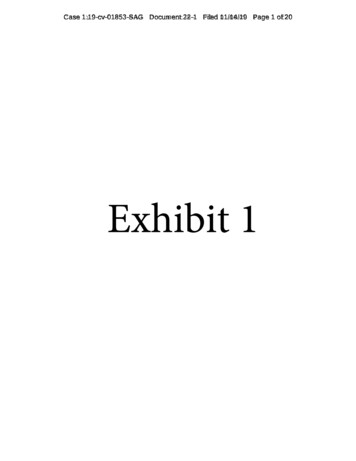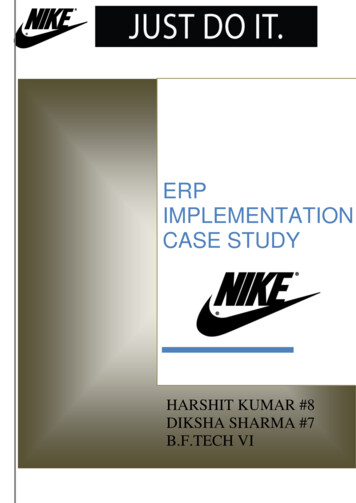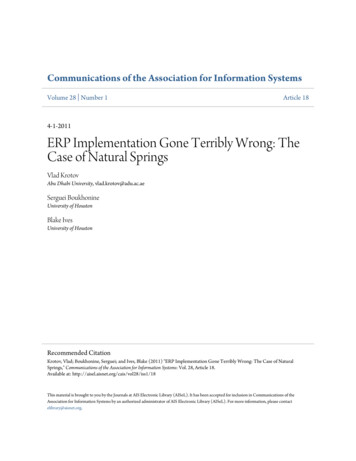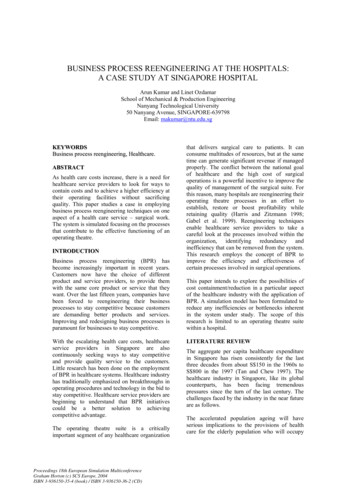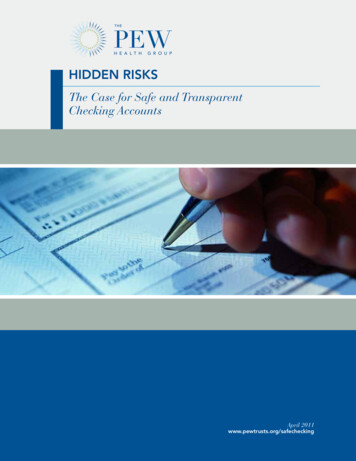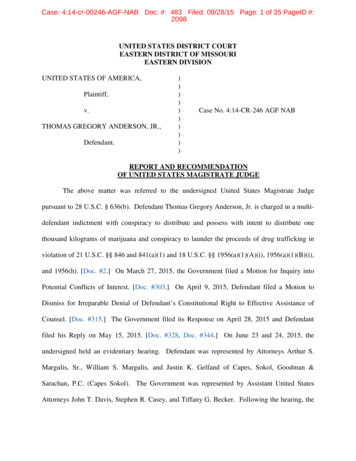
Transcription
Case: 4:14-cr-00246-AGF-NAB Doc. #: 483 Filed: 09/28/15 Page: 1 of 35 PageID #:2098UNITED STATES DISTRICT COURTEASTERN DISTRICT OF MISSOURIEASTERN DIVISIONUNITED STATES OF AMERICA,Plaintiff,v.THOMAS GREGORY ANDERSON, JR.,Defendant.))))))))))Case No. 4:14-CR-246 AGF NABREPORT AND RECOMMENDATIONOF UNITED STATES MAGISTRATE JUDGEThe above matter was referred to the undersigned United States Magistrate Judgepursuant to 28 U.S.C. § 636(b). Defendant Thomas Gregory Anderson, Jr. is charged in a multidefendant indictment with conspiracy to distribute and possess with intent to distribute onethousand kilograms of marijuana and conspiracy to launder the proceeds of drug trafficking inviolation of 21 U.S.C. §§ 846 and 841(a)(1) and 18 U.S.C. §§ 1956(a)(1)(A)(i), 1956(a)(1)(B)(i),and 1956(h). [Doc. #2.] On March 27, 2015, the Government filed a Motion for Inquiry intoPotential Conflicts of Interest. [Doc. #303.] On April 9, 2015, Defendant filed a Motion toDismiss for Irreparable Denial of Defendant’s Constitutional Right to Effective Assistance ofCounsel. [Doc. #315.] The Government filed its Response on April 28, 2015 and Defendantfiled his Reply on May 15, 2015. [Doc. #328, Doc. #344.] On June 23 and 24, 2015, theundersigned held an evidentiary hearing. Defendant was represented by Attorneys Arthur S.Margulis, Sr., William S. Margulis, and Justin K. Gelfand of Capes, Sokol, Goodman &Sarachan, P.C. (Capes Sokol). The Government was represented by Assistant United StatesAttorneys John T. Davis, Stephen R. Casey, and Tiffany G. Becker. Following the hearing, the
Case: 4:14-cr-00246-AGF-NAB Doc. #: 483 Filed: 09/28/15 Page: 2 of 35 PageID #:2099parties submitted post-hearing briefs. [Doc. #405, Doc. #411.]On August 24, 2015, theundersigned heard oral arguments. The undersigned will make the following findings of fact andconclusions of law with regard to the Government’s motion for inquiry and Defendant’s motionto dismiss based upon the parties’ briefs, oral arguments, and evidence adduced at theevidentiary hearing.For the reasons set forth below, the undersigned recommends thatDefendant’s Motion to Dismiss for Irreparable Denial of Defendant’s Constitutional Right toEffective Assistance of Counsel be denied.FINDINGS OF FACTFrom the end of 2012 through January of 2015, Anderson was represented by the lawfirm of Rosenblum, Schwartz, Rogers & Glass, P.C. (RSRG). Attorney N. Scott Rosenblumrepresented Anderson, with assistance from Attorneys Adam D. Fein and Marc Johnson. OnAugust 13, 2014, Anderson was indicted. In mid-January 2015, Capes Sokol began representingAnderson and RSRG withdrew. Capes Sokol brought to the Government’s attention potentialconflicts of interest based on RSRG’s prior representation of CS #1, the confidential informantwhose cooperation led to Anderson’s indictment, and Corey Nuspl, Anderson’s co-defendant.RSRG Attorneys Scott Rosenblum and Adam Fein represented CS #1 from November of 2011through January of 2013 and RSRG Attorney Joel J. Schwartz represented Nuspl from thesummer of 2014 until shortly after indictment.The Government filed a motion for inquiry into the potential conflicts and Capes Sokolfiled a motion to dismiss the indictment based on ineffective assistance of counsel. At theevidentiary hearing, the undersigned held a colloquy with Anderson and found that he knowinglyand intelligently waived his attorney-client privilege and interest in confidential communicationswith RSRG for the purposes of the motion to dismiss. The undersigned then heard testimony2
Case: 4:14-cr-00246-AGF-NAB Doc. #: 483 Filed: 09/28/15 Page: 3 of 35 PageID #:2100from RSRG Attorneys Scott Rosenblum, Adam Fein, Marc Johnson, and Joel Schwartz, as wellas AUSA John Davis. The undersigned will make the following findings of fact with regard toRSRG’s representation of Anderson before and after his indictment.I.Pre-indictment RepresentationCS #1 was indicted in April of 2011. Following his plea of guilty in November of 2011,he retained RSRG to coordinate his cooperation with the Government and obtain a more lenientsentence. RSRG Attorneys Scott Rosenblum and Adam Fein represented him. From January of2012 through January of 2013, CS #1 cooperated with the DEA and provided information thatformed the genesis of the investigation leading to indictment in this case. CS #1 providedinformation about Anderson at fourteen meetings with the DEA. In November of 2012, CS #1was sentenced with the benefit of a 5K1.1 motion by the Government 1 based at least in part onhis cooperation against Anderson. Rosenblum represented CS #1 at sentencing and Fein mayhave also been present. Fein filed multiple motions to continue CS #1’s surrender date forservice of sentence so that he could continue cooperating with the DEA. CS #1 ultimatelysurrendered in January of 2013, following his last contact with the DEA.The sentencing judge as well as the undersigned conducted an in camera review of theGovernment’s 5K1.1 motion and the transcript of CS #1’s sentencing. Both are very general innature. Anderson is not named. Jeannette Graviss, the AUSA on CS #1’s case, was neverpresent at any interview where CS #1 discussed Anderson. Rosenblum testified that CS #1 wasincredibly secretive about his cooperation with the DEA and wanted to do it “off the grid.”1When the Government files a 5K1.1 motion stating that a defendant has provided “substantialassistance,” the sentencing court may depart from the applicable sentencing guidelines and, incertain circumstances, sentence the defendant below the statutorily required mandatory minimumsentence. U.S.S.G. § 5K1.1; 18 U.S.C. § 3553(e).3
Case: 4:14-cr-00246-AGF-NAB Doc. #: 483 Filed: 09/28/15 Page: 4 of 35 PageID #:2101(Evidentiary Hearing Tr. Vol. II p. 24.) No one at RSRG had any knowledge at the time that CS#1 was cooperating against Anderson.With information from CS #1, AUSAs John Davis and Stephen Casey beganinvestigating an extensive marijuana conspiracy. DEA Special Agent Brandon Moles was thelead agent on the investigation. The investigation was ultimately divided into two indictments.AUSA Davis became the lead attorney in this case, while AUSA Casey became the lead attorneyon a second, related indictment involving Kyle Kienstra (4:14-cr-250 CDP).In November of 2012, shortly after CS #1 was sentenced, agents executed searchwarrants on Anderson’s parents’ home and the home of Anderson’s sister Rachel and her fiancéBrian Christopher Hounsom, who was later indicted along with Anderson. Shortly thereafter,RSRG Attorney Scott Rosenblum began communicating with AUSA Davis regarding Andersonand a potential indictment. Rosenblum testified that RSRG began representing Anderson afterCS #1 was sentenced in November of 2012 but before CS #1 surrendered for service of sentencein January of 2013.On February 19, 2014, agents approached co-defendant Corey Nuspl who consented to asearch of his home and indicated a willingness to cooperate. At some point thereafter, RSRGAttorney Joel Schwartz contacted AUSA Davis to set up a proffer interview with Nuspl. Theinterview took place on July 15, 2014 at AUSA Davis’ office. Agent Brandon Moles waspresent, along with two other agents. Agent Moles had also participated in meetings with CS #1where CS #1 discussed Anderson.By the time of the proffer interview, AUSA Davis had had multiple conversations withRSRG Attorney Scott Rosenblum regarding Anderson.He was “well aware” that ScottRosenblum and Joel Schwartz were partners at the same firm. (Evidentiary Hearing Tr. Vol. II p.4
Case: 4:14-cr-00246-AGF-NAB Doc. #: 483 Filed: 09/28/15 Page: 5 of 35 PageID #:2102190.) AUSA Davis testified that Schwartz was “begging” him not to indict Nuspl, arguing hewas “low-hanging fruit.” (Id. at 189.) According to AUSA Davis, at that time, the investigationhad not yet been divided into the two indictments and he was still “juggling” 30 potential codefendants with “no idea” who he was going to indict. (Id. at 189-90.)information about Anderson.Nuspl providedSchwartz guessed the proffer lasted “significantly less” than“several hours.” (Id. at 158.)Agent Brandon Moles testified before the Grand Jury regarding information both Nuspland CS #1 had provided. On August 13, 2014, Anderson and Nuspl were indicted, along withnine other co-defendants, including Brian Hounsom. AUSA Davis contacted RSRG AttorneyScott Rosenblum to let him know that Anderson had been indicted. Some time after Andersonwas indicted and Rosenblum had received discovery, Rosenblum learned that CS #1 wasRSRG’s former client and contacted AUSA Davis to confirm his identity. AUSA Davis did notknow the identity of CS #1 but was able to confirm with Agent Moles.II.Post-indictment RepresentationA week after the indictment, on August 20, 2014, RSRG Attorneys Scott Rosenblum,Adam Fein, and Marc Johnson entered on behalf of Anderson and RSRG Attorney Joel Schwartzentered on behalf of co-defendant Corey Nuspl. Because Anderson was out of the country at thetime, RSRG Attorneys Rosenblum and Fein arranged for him to self-surrender on August 25,2014. United States Magistrate Judge Shirley Padmore Mensah held an initial appearance whereFein was present.The same day, RSRG Attorney Joel Schwartz represented Nuspl at anarraignment before the undersigned.On the morning of August 27, 2014, the undersigned held an arraignment for Anderson.AUSA Davis represented the Government. RSRG Attorney Adam Fein represented Anderson5
Case: 4:14-cr-00246-AGF-NAB Doc. #: 483 Filed: 09/28/15 Page: 6 of 35 PageID #:2103and requested additional time to file pretrial motions. The undersigned granted the request in theinterest of justice and set a pretrial motion deadline of September 25, 2014.Later that morning, Judge Mensah held a detention hearing for Anderson. AUSA Davisrepresented the Government and RSRG Attorney Scott Rosenblum represented Anderson. Thesole witness was DEA Agent Alexander Jenny, who was standing in for Agent Moles. AgentJenny testified as to fears informants for the Government had for their safety, the many firearmsand large sum of currency found at Anderson’s parents’ home, and a 2011 incident whereAnderson sent his bodyguard, Mitchell Hughes, to San Jose, California to rough up KyleKienstra. On cross-examination, Rosenblum established that most of Agent Jenny’s testimonywas hearsay from other investigators. Judge Mensah continued the detention hearing to August29, 2014 to hear testimony from other witnesses, indicating she was primarily concerned aboutthe danger Anderson posed to the community.On August 29, 2014, Judge Mensah held a second detention hearing, beginning atapproximately 4:00 p.m. As with the first hearing, AUSA Davis represented the Governmentand Rosenblum represented Anderson. The Government called two witnesses: Hughes andNuspl. Hughes essentially confirmed Agent Jenny’s testimony. At approximately 5:00 p.m., theGovernment called Nuspl.AUSA Davis established that Nuspl was cooperating with thepossibility of gaining a sentencing benefit. Nuspl testified that he had concerns for his safetyfrom Anderson, that Anderson had threatened him through another individual, and that he hadseen Anderson with firearms on two occasions. On cross-examination, Rosenblum brought outthat Anderson had never directly threatened Nuspl, that Nuspl had never felt the need to reportany concern for his safety, and that Nuspl had seen the firearms in 2011 and had not seen them in6
Case: 4:14-cr-00246-AGF-NAB Doc. #: 483 Filed: 09/28/15 Page: 7 of 35 PageID #:2104the context of a drug transaction, or near drugs or large sums of currency. The proceedingsconcluded at 5:22 p.m.On September 2, 2014, Judge Mensah ordered Anderson be detained. [Doc. 74.] JudgeMensah found by clear and convincing evidence that:Defendant’s release would present a danger and threat to potential witnesses inthe case. The evidence presented included credible, unrebutted testimony by apaid informant that, on at least one occasion, Defendant hired the informant to flyto California to assault and intimidate an associate; credible unrebutted testimonyby a co-defendant that he fears for his safety based on his own observations ofDefendant with firearms, his knowledge of Defendant’s ‘vengefulness’ and anindirect threat Defendant made to this co-defendant; evidence presented by thegovernment that Defendant’s parents, with whom he initially proposed to residepending trial, were involved in his activities and are also targets of the ongoinggovernment investigation.[Doc. 74 p. 2.]RSRG Attorney Adam Fein filed a motion to revoke Judge Mensah’s detention order.[Doc. 195.] United States District Judge Audrey G. Fleissig held a hearing on the motion whereNuspl again testified, along with another co-defendant, Brian Lee Lord.Anderson wasrepresented by RSRG Attorneys Rosenblum and Fein. Lord testified as to Anderson’s generalinvolvement in the drug conspiracy, an occasion in 2012 when Anderson asked him to transportfirearms to Boston for 5,000, and a 2011 incident when Anderson threatened an individual in anightclub by flashing his firearm. Nuspl’s testimony was short. He testified that Anderson’ssister Rachel sent a group text containing Nuspl’s earlier testimony that he was cooperating andhad concerns for his safety. On cross-examination, Rosenblum suggested Rachel was clearingthe record because Nuspl had said Anderson was cooperating and that he was not afraid ofAnderson. Following Nuspl’s testimony, Fein proffered testimony to that effect from Rachelwho invoked her Fifth Amendment right against self-incrimination. Judge Fleissig indicated she7
Case: 4:14-cr-00246-AGF-NAB Doc. #: 483 Filed: 09/28/15 Page: 8 of 35 PageID #:2105would not give much weight to proffered testimony from a witness invoking her FifthAmendment rights.Fein argued that Anderson had no history of violence, that the incidents discussed werefrom years ago, that Anderson lawfully possessed his firearms and no longer had access to them,and that Nuspl’s testimony about the text and indirect threat were too attenuated and minor tosupport an order of detention.AUSA Davis emphasized that Anderson faced a ten-yearmandatory minimum, which carries a presumption of detention. He further argued that that therewas plenty of evidence that Anderson was hot tempered, had threatened people, and possessedfirearms in connection with his drug business.Judge Fleissig did not revoke Judge Mensah’s order. [Doc. 249.] In fact, she wentbeyond Judge Mensah in finding that Anderson was a flight risk because he had few noncriminal ties to the Eastern District of Missouri, had lived in multiple countries, had recentlycrossed the U.S.-Mexico border undetected, and was facing a significant sentence.JudgeFleissig further found that Anderson was a danger to the community. She determined that therewas probable cause to believe he was the leader of an extensive drug conspiracy, corroborated inpart by intercepted calls, a conspiracy that was on-going when he hired Hughes and had himassault Kienstra.Judge Fleissig also found that Anderson owned multiple firearms, hadthreatened an individual with one in 2011, and had offered to pay Lord to transport his firearmsto another state in 2012. Acknowledging the lack of temporal proximity, Judge Fleissig foundNuspl’s testimony significant:While it is true that the events related in the above paragraph occurred a few yearsago, there is evidence from the prior hearing that, recently, Defendant indirectlythreatened a co-Defendant who has cooperated. Even more recently, after thedetention hearing Defendant’s sister sent a text message to at least six individualsin which she attached a few selected pages from the transcript of the hearingbefore Judge Mensah, which pages specifically identify an individual as8
Case: 4:14-cr-00246-AGF-NAB Doc. #: 483 Filed: 09/28/15 Page: 9 of 35 PageID #:2106cooperating with the Government. The Court finds especially disturbing that thetranscript of that hearing was filed under seal.[Doc. 249 p. 7.]On September 4, 2014, RSRG Attorney Joel Schwartz moved to withdraw as counsel forNuspl and Attorney Patrick S. Kilgore, a solo practitioner, formally entered on Nuspl’s behalf.As a result, the undersigned vacated a conflicts hearing previously set for September 5, 2014.Although the docket sheet reflects that Attorney Kilgore entered and RSRG AttorneySchwartz withdrew on September 4, 2014, Kilgore began representing Nuspl before then. Atsome point following indictment, “probably days” before the first detention hearing, when itbecame clear that the conflict was unwaivable, RSRG Attorneys Schwartz and Rosenblum had aconversation where Rosenblum instructed Schwartz to withdraw. (Evidentiary Hearing Tr. Vol.II p. 36.) Schwartz testified that he effectively withdrew at that point but did not formallywithdraw until after Kilgore agreed to represent Nuspl. Schwartz recalled that Nuspl retainedKilgore shortly after indictment. AUSA Davis recalled that after the first detention hearing,when it became clear Nuspl would have to testify, he told Schwartz and/or Rosenblum thatRSRG could not continue to represent both defendants. At least by the time of the seconddetention hearing on August 29, 2014, Kilgore was representing Nuspl and Schwartz had nofurther involvement in the case.RSRG Attorney Marc Johnson was in regular contact with co-defendant Brian Hounsom,Anderson’s sister’s fiancé, who relayed messages from Anderson’s family and repeatedlyrequested that Johnson represent him. 2On the morning of September 12, 2014, Johnson2Hounsom was initially represented by Attorney Burton H. Shostak and is now represented byAttorney James W. Schottel, Jr. In a September 9, 2014 email to Johnson, AUSA Davis advisedthat it would be a conflict for him to represent Hounsom. (Ex. I.) Johnson maintains that henever advised Hounsom regarding this case. Rosenblum testified that he was aware of contact9
Case: 4:14-cr-00246-AGF-NAB Doc. #: 483 Filed: 09/28/15 Page: 10 of 35 PageID #:2107obtained Anderson’s cell phone from Hounsom and brought it to Anderson in the Warren CountyJail in Warrenton, Missouri. Johnson testified that Hounsom had informed him that Andersonneeded a number out of the phone so that he could pay RSRG. Rosenblum testified thatAnderson was paid in full at the time. Johnson arrived at the jail at 12:08 p.m. (Ex. H.) Johnsontestified that he was not sure that the phone in fact worked and did not know why Hounsomcould not relay the number himself. Johnson recalled Anderson putting the phone to his ear.Johnson testified that Anderson was absolutely not supposed to use the phone and that he wasquite upset when Anderson attempted to use it. At some point, Anderson took two “selfies” thatare timestamped 12:17 p.m. that day. (Exs. F & G.) Johnson had no recollection of Andersontaking the selfies. Anderson wanted Johnson to leave the cell phone with him, but Johnson tookit back to his office and left it at the front desk.On September 24, 2014, the Government filed a motion for a complex case findingpursuant to 18 U.S.C. § 3161(h)(7)(B)(ii). [Doc. 150.] In support of the motion, the Governmentstated that the case involved a complex long-term conspiracy, eleven defendants, voluminousdiscovery, and several arguably suppressible events, and that in light of the foregoing, it wouldbe unreasonable for defense counsel to effectively prepare within the time limits established bythe Speedy Trial Act, 18 U.S.C. § 3161 et seq. On September 25, 2014, RSRG Attorney AdamFein filed a first motion for additional time on behalf of Anderson, citing the Government’smotion. [Doc. 155.]On September 26, 2014, the undersigned entered an order making a complex case findingfor the reasons set forth in the Government’s motion and setting a status conference for Octoberbetween Johnson and Hounsom but was not aware of any unauthorized contact and hadinstructed Johnson not to discuss specifics of the case or give spec
RSRG Attorney Scott Rosenblum began communicating with AUSA Davis regarding Anderson and a potential indictment. Rosenblum testified that RSRG began representing Anderson after CS #1 was sentenced in November of 2012 but before CS #1 surrendered for service of sentence in January of 2013.File Size: 210KB





